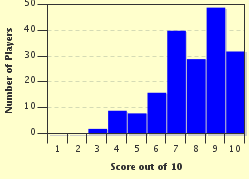Quiz Answer Key and Fun Facts
1. A long time ago, in 53 BC, the Romans needed gold to finance their extensive military activity. In one of their invasions to get gold, they encountered a fast, well equipped army that surprised the Romans and thwarted their intent to conquer. Which empire, also known as the Arsacid Empire and located in modern-day Iran was this?
2. In 1274 and 1281, the country of Japan was the target of an invasion, which miserably failed. These invasions were undertaken by Kublai Khan, famous military leader and founder of the Chinese Yuan Dynasty. Which group of people did Khan lead and fail when seeking to invade Japan?
3. Korean Admiral Yi Sun-sin stopped the Japanese from invading Korea in the 16th century. In the late 1500s, the Japanese attacked Korea in order to conquer the territory, and use it to invade China afterwards. However, this invasion was unsuccessful, and led to the death of which Japanese general from the Sengoku period?
4. Napoleon Bonaparte had turned France into a victorious country. This military genius managed to finally bring order in a shaken France, after the French Revolution. However, in June of 1812, he made a terrible mistake. Which country did he unsuccessfully try to invade, causing the death of the majority of the French soldiers?
5. In the War of 1812, the United States tried to invade Canada. The operation seemed as if it would be a "piece of cake", since the U.S. was about 15 times bigger than Canada, but the Americans failed in their try to annex Canada, at that time a colony of which country?
6. During the First World War, Russia was allied with Britain and France. With the Gallipoli Campaign of 1915, Britain, together with Australia and New Zealand, tried to force open a strait so that it could be used by the Russians as a sea route to the West. However, Winston Churchill's idea failed and the Allies were defeated by an army of Ottomans. Which strait, formed on one side by the Gallipoli Peninsula, was the this?
7. World War II started on September 1, 1939 and ended in 1945, as the war with most human losses in history. The war was fought between the Axis powers (Germany, Italy and Japan and others) and the Allied powers (United States, United Kingdom, France, China and others). Even though the Soviet Union had at first supported the Axis powers, Hitler launched which invasion attempt on June 22, 1941?
8. By 1961, the United States had consolidated itself as a world superpower, being one of the two most powerful countries on the planet. After succeeding in both World Wars, the U.S. focused on containing communism, and intended to overthrow a government in Cuba through the Bay of Pigs invasion, which turned out to be a big embarrassment for the United States. Whose government was the U.S. trying to remove?
9. Even though the Cold War was between the United States and its allies on the one hand and the Soviet Union and its allies on the other, several countries all over the world were involved in the conflict. In 1979, the Soviets decide to support Communism in South Central Asia, so they tried to invade Kabul and its surroundings, failing and losing both soldiers and money in the process. Which country successfully resisted the entrance of the Soviets?
10. In 2003, troops from the United States arrived in Iraq. The main point of this invasion was to eliminate weapons of mass destruction that supposedly existed in Iraq. Under whose administration did the invasion of Iraq happen?
Source: Author
Lpez
This quiz was reviewed by FunTrivia editor
bloomsby before going online.
Any errors found in FunTrivia content are routinely corrected through our feedback system.

